Okay, it’s definitely official! After your first experience of huffing, puffing, straining, pulling, pushing, and screaming to reach the top of a climbing route in Cantabaco or in a wall climbing facility, you finally admit it: you’re on the verge of becoming a rock climbing addict.
You tell yourself that in the coming weekends, you are going to stare at Death in the face when you scale treacherous limestone cliffs to prove to yourself and the world that you can overcome all kinds of obstacles. After that life-changing weekend, you decide to make rock climbing your own sport and recreational activity to escape the hustle and bustle of the city, to relive yourself of stress, and to meet new friends.
However, rock climbing is a journey. Just like all journeys, if you want to get serious, you need to start somewhere. But how? Different climbers suggest a myriad of ways to kick-start the sport: browsing the Internet for rock climbing advice, joining a group of rock climbers, climb regularly in a climbing gym, and so on.
In our collective personal opinion, getting your personal rock climbing gear is the best way to start if you wish to get serious in this sport. You may ask, Really? But they told me that I need to get some experience first before buying those gears! Yes, that’s true. But consider the following advantages if you have acquired your own gear:
1. You save money—lots of it. If you don’t have your own gear, you are forced to rent some. If you climb every weekend, you are going to spend a whole lot of money from rentals. That does not include the guide fee, fare, food, overnight stays, and other miscellaneous expenses.
2. You are encouraged—or forced—to climb regularly. Having your own gear encourages you to maximize climbing sessions. You will love the feeling of slipping on your own harness, tying your own rope, and relying on your own quickdraws. Furthermore, buying rock climbing equipment is a considerably large investment, and you wouldn’t want your investment to go to waste. Thus, you would need to make full use of your gear. Obviously, this means you need to climb…a lot!
3. You feel safer. Browse several rock climbing websites and you will encounter the same guideline: purchasing and utilizing used gear is NOT recommended. That’s because you don’t know how the previous owner used and maintained that gear. How sure are you that the core of that used rope is still intact? Are you sure that the webbing of that used harness is not frayed? Used rock climbing gear may be inexpensive and still be tough as nails, but personally, we’d rather be on the safe side. Remember that in rock climbing, your life is at stake. At that high a risk, you would definitely want to own equipment which you are totally sure of.
4. It’s more convenient to climb. If you don’t own your own equipment, you will have to wait for a climber to finish his attempt to scale a route so that you can use his gear. That may mean a long wait before you can finally climb the same route.
5. Your gear is specifically for you. Let’s say you are a smallish lady. What if the smallest available pair of climbing shoes is way bigger than your foot size? What if the available harness is too big for you? What if the right-sized harness for your tiny waist is kiddie sized?
6. It’s more hygienic. Do you really want to wear climbing shoes which is previously worn by someone with a foot infection? What about a harness that is soaked with sweat? Yuck!
Owning your own gear makes perfect sense, right? For us, it does!
Now, which rock climbing gear should you get first? The photo below shows our sport climbing gear.
We know what you’re thinking, Hey, wait! That’s a whole lot! Worry not, fellow adventurer, you are not going to get everything. What you want to get are just the essentials: a pair of right-sized rock climbing shoes, a good-fitting climbing harness, and a sazzy chalk bag. And that’s in order!
We’ll start with rock climbing shoes. Rock climbing shoes are footwear that is specifically designed for rock climbing. Did we say “specifically?” Yes, we did. These shoes are not suitable and uncomfortable for walking or hiking. In fact, you should only wear them only at the base of the cliff when you are ready to climb and take them off once you touch the ground.
Typically, these lightweight shoes are constructed to conform very closely to a climber’s feet. Most importantly, they feature sticky rubber soles with extended rubber rands. With the right amount of pressure, the rubber soles allow your foot to “stick” to the wall.
We will not go into the details of the construction or kinds of climbing shoes; that will be discussed in another article. However, it is very important that you know how to choose the right climbing shoes. Remember that these footwear are the interface between you and the rock, and the right-fitting shoes are critical to your climbing performance.
* Make sure that the shoe fits you tightly, which means you should choose shoes that are 1 or 1 ½ size smaller than your standard shoe. In fact, you should be able to feel your toes touch the tip of your shoe. Some climbers even prefer their toes to be slightly and comfortably curved.
* Ensure that there isn’t any dead space between your toes and the inside of the shoe. If there is dead space, your footwear would be unable to stay rigid when you put your toes on a tiny foothold.
* Make sure that the heel has a snug fit. The back of the shoe should not pinch the bottom of your Achilles tendon.
The objective is to make the shoes conform to your feet as closely as possible.
The next essential rock climbing gear you should buy is your climbing harness. We have two: a lightweight Black Diamond Alpine Bod and a cool Black Diamond Momentum.
Your safety depends greatly on your harness. It is your vital link to secure yourself to a climbing rope or an anchor point.
There are many types of harnesses, but what we commonly use is a sit harness. A sit harness basically comprises a waist belt attached to two leg loops. The attachment point is a piece of webbing called a belay loop. Sport climbing harnesses often have gear loops on the waist belt where you can attach quickdraws, cams and other gear. Sit harnesses are quite popular because they offer a huge range of movement while maintaining a superb level of safety. Think of a sit harness as a portable seat when you are climbing.
Just like your climbing shoes, you should ensure that your climbing harness has a good fit.
* Just like clothes and pants, harnesses are categorized by sizes: small, medium, large and the in-betweens. When fitting a harness, make sure that the waist belt does not move excessively. If shifting does happen, tighten the straps until the movement ceases. The harness should not be too tight that it digs through your skin. If you feel painful points of pressure, choose another harness.
* After the waist belt is tightened, put your hand through it. Make a fist and try to pull your hand out. If you can’t pull it out, then the fit is right. Also, you shouldn’t be able to move your harness down your hips once the belt is tightened.
* Adjust the leg loop straps until they are snug and comfortable. If you feel strained in keeping yourself outright, adjust the strap that is attached to the waist belt at the back of the loop. Shortening the straps will enable you to sit upright in the harness without your butt protruding.
* Pull the belay loop up as hard as you can to simulate weight. It should feel relatively comfortable and should not “bite” on your groin or legs.
One last piece of advice: make sure your harness has passed safety standards. Check the label if it has passed the Union Internationale des Associations d’ Alpinisme (UIAA 105). If this is not indicated, check if it has been approved by the European Committee for Standardization (EN 1277).
We will discuss more about properly using the harness in another article.
The last piece of essential gear to acquire is the chalk bag. You can go a bit freely here; chalk bags are like fashion statements—rock climbing fashion, that is.
A good-quality chalk bag usually has a stiffened rim to hold them open so it’s easy for you to dip your hands in. It also features a fleece lining to hold chalk dust and to distribute the chalk evenly around your fingers and hands. It may have a cord-and-toggle closure to prevent chalk from spilling when not in use.
Our Karrimor chalk bag has a waterproof cover, a small pocket for holding small items such as jewelry, and an elastic loop to hold an old toothbrush (used to scrub off old chalk from holds).
Chalk bags come in different sizes, designs, and colors. Whatever bag you choose, make sure you can get your hand inside the opening.
There you have it, the basic gear for sport climbing. In the next article, we’ll talk about how to use your gear properly.
IMPORTANT NOTE:
You need to know rock climbing is an inherently dangerous sport. Although blogs (including ours), books, tutorial videos, and articles could be a good source of information, you should find a certified climbing instructor to properly coach you through the sport. Please contact Enie Yonson at 0943-0688985 or 0948-7124875. You can also search his name on Facebook or send a message to him through the BASO..body and soul outdoor Facebook page. He is a local guide and a certified coach. We learned our climbing skills under his tutelage . . . and we’re still learning. Please do keep in mind that we are NOT climbing instructors.
For details about Cantabaco itself, click here.
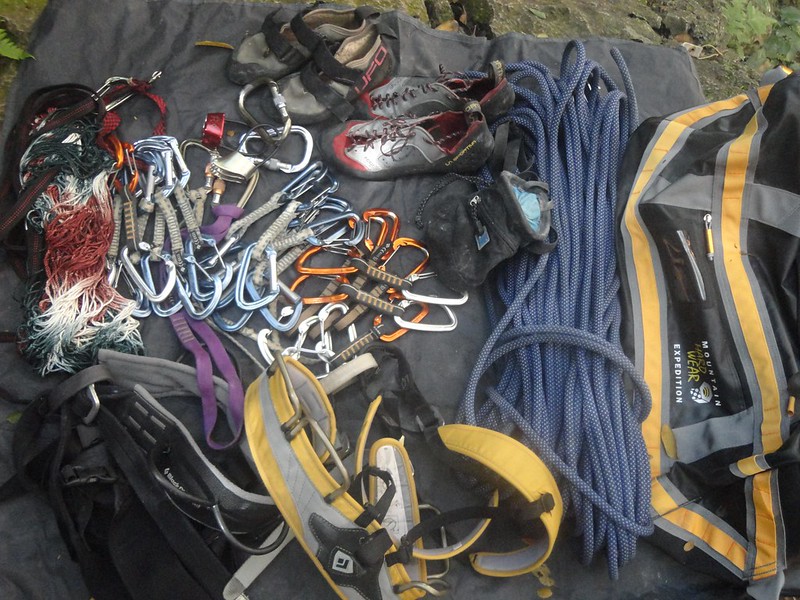
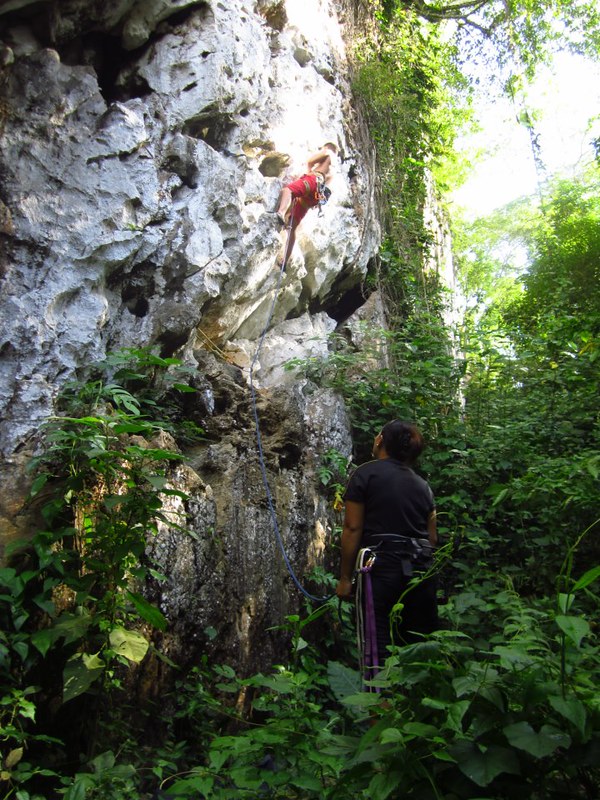

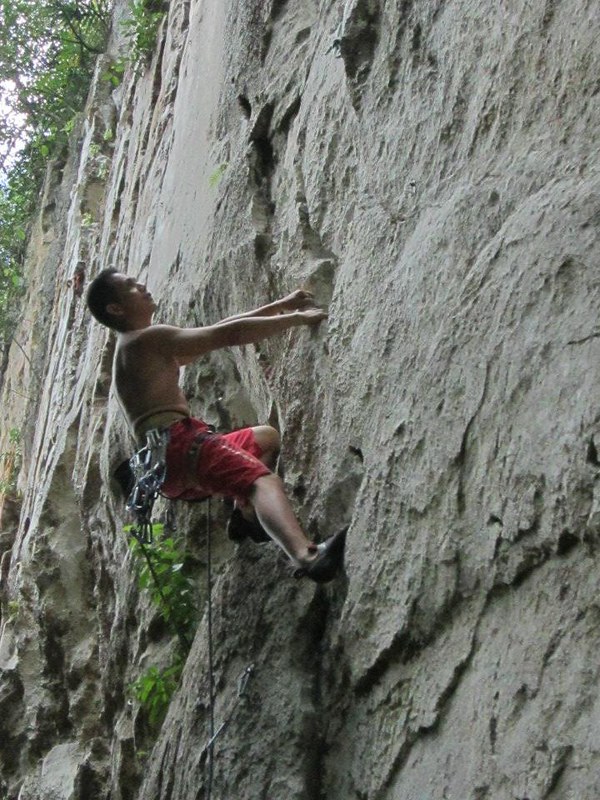
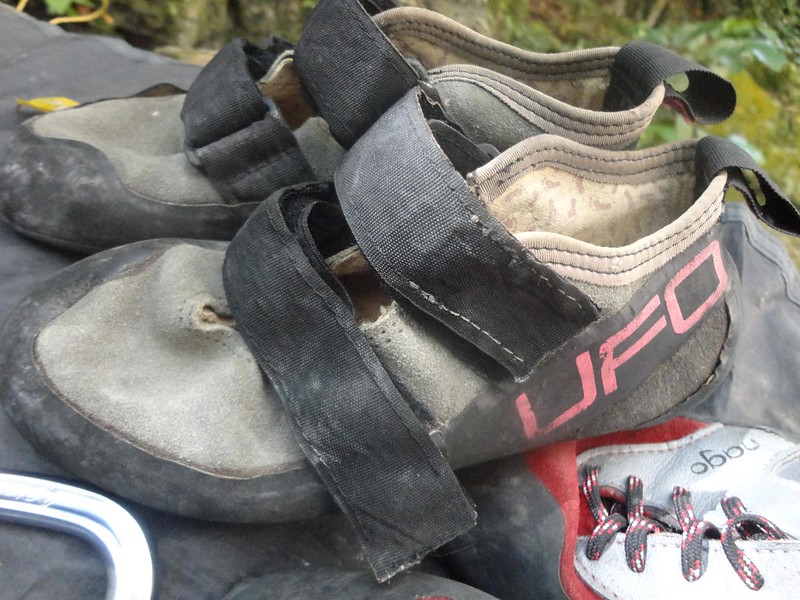

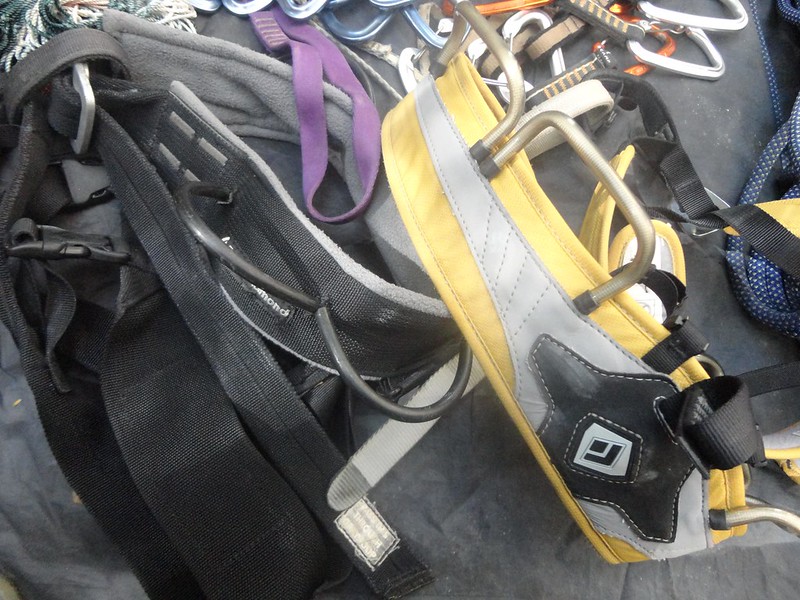
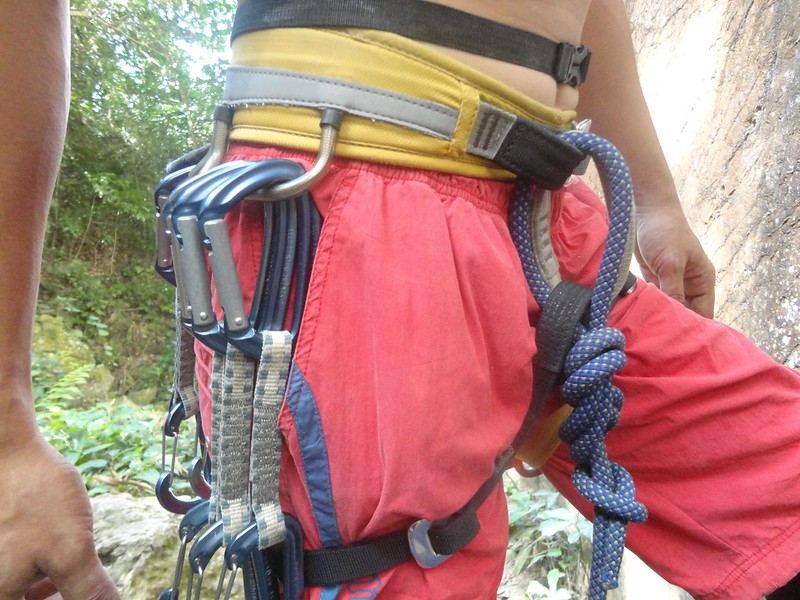
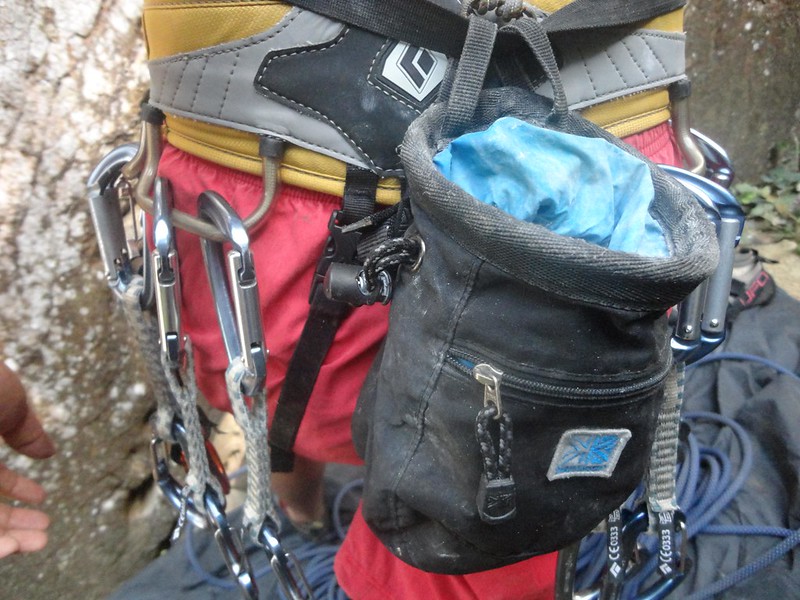
Detailed post! If only I have the funds, I would get into rock-climbing myself. I’ve always savored the activity when given the opportunity– rappelling at the end feels so awesome too!
Rock-climbing is a sport that needs attention to detail–from purchasing down to caring for your equipment. Choosing the proper gear for mountaineering takes an awful lot of careful consideration; I would imagine more so for rock-climbing gear! Your life is practically at the mercy of your gear, so one really needs to thoroughly examine and weigh their options. And that means, second-hand gear is a definite no-no! 🙂
Great post, Team Sweetie! Who knows, one day we might be able to purchase our own rock-climbing gear too. Mine will definitely be kiddie-sized. 😉
Hi Iris,
Yes, you’re correct. In rock climbing, lives are at stake, so getting the right equipment is extremely vital for safety.
If you plan to go rock climbing in Cebu, please do give us a call. We can take you there, and the local guides in Cantabaco will be happy to let you experience the thrill of this extreme sport.
I just added this website to my rss reader, excellent stuff. Can’t get enough!
Turstyka,
Thank you for the follow. Keep posted for more of our adventures. 🙂
Your decision is final: you want to be a poser and not a real climber, just someone who’s all sizzle and no steak, all pictures and no hard work, not even an area 5 climb.
Yrn (a.k.a. Eric Coffman),
Do we just pose and not actually climb/lead? We actually do what we show in the photos. You’ve seen us in action. We progress in our pace and work hard enough according to what our body is telling us. We never sought your approval nor did we ask for your opinion on our progress or anything else for that matter. We’ll start with Area 5 and newer routes when we feel we are ready, definitely not because you think we should. Go and be a lion steak by yourself.
Of your 20 years of climbing, isn’t it time for you to be an expert now and start your own blog? Should you be the one encouraging the beginners and not dissing their efforts? Your hard work really got into your head, and that’s just SOOOO pathetic.
Yrn: I don’t think Sheila and Gian are up for something you want them to be (or maybe not at this time). How could you have the audacity to call them posers? Dude (or dudette or whatever you are), I can see that you’re just plain jealous. There is an infinite number of blogs about mountain climbing on the internet that you can troll with. This I wonder: why do you spend so much effort talking shiz about what they do? I bet you have some undisclosed attraction with either Gian or Sheila. Just saying. Duh!
sir gian i saw you already in the crag in cantabaco you probably don’t remember me but i just wanna ask where could i buy those BD harness … cuz i really got addicted to the rock climbing sport . and i already leaded bhemian(2takes haha) vulva and hait
Hi Kim,
Thank you for visiting our blog. Wow! Congrats on your success on lead climbing Bohemian and Vulva. I remembered it took me about 5 different tries before I could lead Bohemian. Hehe!
You can buy BD harnesses in either Habagat SM or ROX Ayala. However, they might be a bit pricey.
Try to contact our friend Sir Jessie (a.k.a. Godafather Singson on Facebook) at 0942-1746777, 0933-3465955, or 0939-9380552. He sells climbing gear, mountaineering equipment, and climbing apparel at affordable prices. If you can’t contact him through phone, you can send him a message on FB.
Hope this helps. Rock on!
thanks for the fast reply unfortunately i already bought a new harness in R.O.X ayala >.< ahaha Black diamond Bod Harness
Hi Kim,
Ah, okay. Black Diamond Bod Harness is a good choice.
Hi,
You have made useful points. Rock climbing is, no doubt, a dangerous sport. Supervision of a qualified rock climber may help in reducing the risk. However, rock climbing enthusiasts should also work on overall fitness, especially upper body fitness and mental endurance level, before joining the sport club and / or hiring a personal instructor.
Cheers!
Mr. Gian,
I’m a beginner and want to acquire my own gear, however I will just stay in Manila for a week or two, and I am not that familiar with the place. Do you happen to know any shop and their location in Manila that I can visit having good rock climbing shoes. Secondly, have you ever used a Tendon Dynamic Rope Ambition 10.2mm because I’m planning to get one, and this will be my first. I would really appreciate it if you can give me comments/drawbacks to help me decide the climbing rope that I need to buy.
I like your site, specially the suggestion and the gear reviews.
Thanks in advance.
Hi Rollie,
Thanks for checking out our blog and for the complement. We’re not familiar with stores in Manila that sell rock climbing shoes; we live in Cebu anyway. However, you might want to try to go to ROX (Recreational Outdoor Exchange) there. Check out the ROX Facebook Page for the address and contact details of their branches in the Philippines. A few months ago, we sent their marketing department an e-mail requesting for rock climbing shoes in their inventory. Hopefully, they’ll be available in ROX’s shelves now.
We don’t have a Tendon Dynamic Rope, but one of our climber friends has one. The rope is really good, a little stiff during the first few uses. It has a somewhat coarse feel, but this should not be seen as a drawback. The coarse sheath allows you to have a better grip on the rope.
We checked out a few online reviews for you, and it seems to be a high-quality rope. A rope with a diameter of 10.2mm is great; the thicker length makes it long-lasting. Just make sure the length is at least 60 meters.
Hope this helps. Thank you and rock on!
Great feedback. Took the Tendon rope. Thanks for the reply.
[…] Rock Climbing 101: The Gear […]
You’re not in the barefoot school of rockclimbing, obviously? It’s been ages (I won’t tell you how long) since I dabbled in this, but there were still a few barefoot devotees around. 🙂
Hi B,
Hehe! No, we’re not in barefoot school. We guess feet are more tender today. Hahaha!
😀
[…] Source: https://adrenalineromance.com/2013/02/04/rock-climbing-101-the-basic-gear/ […]